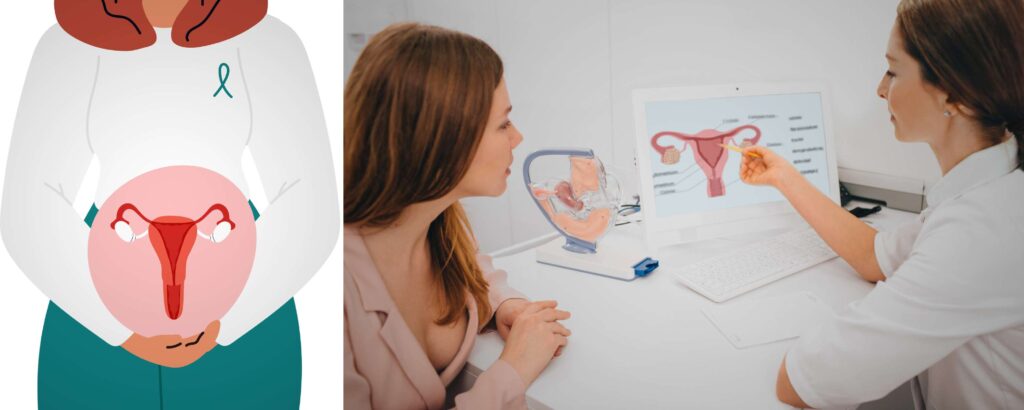

Cervical Cancer Awareness Month: All You Need To Know About HPV And Cervical Cancer
An Overview
January is Cervical Cancer Awareness Month. It is an annual commemoration conducted during the month of January to raise awareness about cervical cancer globally. Cervical cancer develops in the cervix, the lower part of the uterus, which opens into the vagina (birth canal). Often, it begins slowly with cervical cell dysplasia and precancerous alterations. Cervical cancer is most commonly caused by the Human papillomavirus (HPV), a sexually transmitted infection.
As per the World Health Organization (WHO), cervical cancer is recognized as the fourth most common type of cancer in women, with an estimated global incidence of 604000 new cases and 342000 deaths in 2020. As we observe Cervical Cancer Awareness Month in January 2024, it is imperative to shed light and draw awareness to this serious health issue that affects women worldwide. [1]
What is the Human papillomavirus (HPV)?
The human papillomavirus, also known as HPV, is a group of more than 200 related virus strains that affect different parts of the body. Most people with HPV infections are asymptomatic, while some strains are known to cause warts and cancer.
Most HPV strains cause warts on different body parts, such as arms, feet, hands, or chests. Other HPV strains are found on the mucous membranes, which are the moist surface layer that lines organs that open to the outside such as the vagina, anus, mouth, or throat. These HPV strains are called genital HPV strains and cause sexually transmitted infections that are spread through skin-to-skin contact.
Sexually transmitted HPV strains fall into two categories: low-risk HPVs and high-risk HPVs.
- High-risk HPV: There are 12 high-risk HPV strains that are responsible for HPV-related cancers, including cervical cancer.
- Low-risk HPV: Low-risk HPV strains rarely cause cancer but are responsible for causing warts (papilloma) on different parts of the body including the genitals, anus, mouth, or throat. [2, 3, 4]
5 lesser-known facts about HPV infection
- HPV infection is common: Almost all sexually active people, irrespective of their gender, or sexual orientation, will be infected with HPV infection without any symptoms at some point in their life within months to a few years of becoming sexually active.
- Most HPV regress on their own: Most HPV infections regress on their own without causing cancer, and in most cases, body’s immune system clears the infection from the body on its own.
- Persistent high-risk HPV infections cause cancer: Persistent infections with high-risk HPV can cause cellular abnormalities, which, if left untreated, may get worse and become precancerous and later cancerous.
- HPV causes 6 types of cancer: HPV causes six types of cancer, which include cervical cancer, anal cancer, oropharyngeal cancer, penile cancer, vaginal cancer, and vulvar cancer.
- HPV vaccination can prevent cancer: HPV vaccinations can prevent infection with disease-causing HPV strains, hence reducing the risk of many HPV-related cancers and genital warts. [1,2]
Are all warts HPV?
Yes, all warts are caused by HPV, but all HPV strains don’t cause warts. This begs the question: what is the difference between HPV strains that cause warts on the skin or genitals and the HPV strains that cause cervical cancer?
Wart-causing HPV strains, particularly those that cause genital warts, are bothersome and harmless. HPV strains 6 and 11 are the most prevalent causes of genital warts. Other strains of HPV cause the following types of warts:
- Common warts
- Flat warts
- Plantar warts
- Periungal and subungual warts
The type of HPV that progresses to develop into cancer doesn’t cause warts. [4]
How are HPV infection and cervical cancer-related?
The cervix is the lower end of the uterus, which connects the uterus (womb) to the vagina, also known as the birth canal. Cervical cancer originates in the cervix and can affect deeper tissues of the cervix and metastasize to different parts of the body. High-risk HPV strains (types 16 and 18) infect the cervix, disrupting cellular replication, division, and communication, causing infected cells to proliferate uncontrollably, and resulting in cervical dysplasia. If left untreated, cervical dysplasia can develop into a malignancy.

Genital HPV strains that result in sexually transmitted infections are the primary cause of almost all (95%) cervical cancers.
- HPV is transmitted through any intimate skin-to-skin contact (anal, vaginal, or oral) and doesn’t necessarily spread through penetrative sex.
- Squamous cell carcinoma and adenocarcinoma are the two main types of cervical cancers.
Dysplastic cells in the cervical lining typically take 15 to 20 years to turn cancerous, but in women with compromised immune systems, this time frame can be shortened for precancerous conditions to progress into a malignancy. [1, 2, 4, 5]
Signs and Symptoms of Cervical Cancer
The early stages of cervical cancer are mostly asymptomatic and difficult to detect. The first signs of cervical cancer might take several years to develop, and finding abnormal (hyperplastic and dysplastic) cervical cells during cervical cancer screenings like pap smears is the best way for early detection and prevention of cervical cancer.
Signs and symptoms of stage 1 cervical cancer include:
- Thick, red, or watery vaginal discharge with a foul odour
- Vaginal bleeding occurs during sex, in between menstrual cycles, or following menopause.
- Heavier menstrual periods that might last longer than usual.
If cervical cancer has metastasized to different body parts, symptoms might include:
- Painful urination or blood in the urine (hematuria)
- Diarrhoea, painful, or bloody stool
- Fatigue, loss of appetite, and weight
- Pelvic or abdominal pain
- Dull backache
- Swelling in the legs
- The general feeling of illness (myalgia) [5]
How is cervical cancer diagnosed?
Pap smears, or HPV tests, are the two cervical cancer screening tests which are used to detect cervical cancer.
- Pap smear: This test detects abnormal cellular changes (hyperplasia and dysplasia) in the cervical lining.
- HPV Test: This test checks cervical cells for high-risk HPV infections that are most likely to cause cervical cancer.
A gynaecologist might suggest an HPV/Pap co-test for individuals over 30 years of age. [2, 5]
HPV vaccine: Preventing HPV infection and cervical cancer
The HPV vaccination Gardasil 9 guards against infection from nine HPV types, including the two low-risk forms that cause the majority of genital warts (types 6 and 11) and the seven strains that cause the majority of HPV-related cancers (types 16, 18, 31, 33, 45, 52, and 58). It is important for everyone to get vaccinated because anyone, regardless of their gender and sexual orientation, can get infected with HPV infections that might cause cancer later in life.

Key points about HPV vaccination:
- The HPV vaccine is estimated to prevent up to 90% of cancers caused by HPV infection and genital warts.
- The HPV vaccinations offer the most protection when administered between the ages of 9 and 12.
- Both males and females are eligible to receive HPV vaccinations.
- HPV vaccines can only prevent HPV infections; they don’t aid in the treatment of a pre-existing infection.
- It is recommended that teens and young adults (13 to 26 years old) who have not been vaccinated or completed all of their vaccination shots get the vaccine as soon as possible.
- Two vaccine doses should be administered to individuals who begin the vaccination series before the age of 15, and three doses should be administered to those who receive their first dose at or after the age of 15.
- The American Cancer Society (ACS) does not recommend HPV vaccines for individuals older than 26 years.
The FDA has approved the vaccination to be given through the age of 45 years. However, it is not generally recommended for most adults aged 27 to 45 because people in this age bracket have likely been exposed to HPV already, and the vaccine won’t prove beneficial for them. [2,3]
Management and Treatment of Cervical Cancer
Treatment for cervical cancer includes radiation, chemotherapy, surgery, targeted therapy, and immunotherapy.
Radiation Therapy
- Radiation therapy employs energy beams to eliminate cancerous cells from the cervical lining. External beam radiation treatment (EBRT) and brachytherapy are the two forms of radiation therapy.
Chemotherapy
Chemotherapy uses drugs that are either taken orally or intravenously to kill cancer cells. Chemotherapy is typically administered in cycles. The medication used and the location of the cancer affect the cycle’s duration as well as the timing and frequency of chemotherapy sessions.
Surgery
Some different kinds of surgery that are used to treat cervical cancer include
- Laser surgery: This surgery employs a laser beam to burn off cancerous cervical cells.
- Cryosurgery: Cancerous cells are frozen in this surgery.
- Hysterectomy: A hysterectomy is a type of surgery that involves the removal of the uterus but not the tissue surrounding the uterus.
- Radical hysterectomy with pelvic lymph node dissection: This surgery involves the removal of the uterus, tissues surrounding the uterus (parametrium), cervix, a small portion of the upper part of the vagina, and pelvic lymph nodes.
- Trachelectomy: This surgical procedure involves the removal of the cervix and upper part of the vagina, but not the uterus.
- Pelvic exenteration: This procedure is the same as radical hysterectomy but involves the removal of other body parts as well, like the urinary bladder, vagina, rectum, or a part of the colon in case of metastasis. [5]
How can cervical cancer be prevented?
With over 200 strains of HPV, there is no foolproof method to avoid infection. However, certain preventive measures might reduce the risk of viral transmission. Moreover, vaccinations against the strains of HPV that are most closely associated with genital warts and cancer are available for use in teenagers and young adults. Some ways to prevent cervical cancer include the following:
- Get vaccinated if you are within the age limit.
- Use condoms and other contraceptive barriers during sex
- Limiting sexual partners
- Quit smoking and using tobacco products
- Scheduling regular gynaecological check-ups
- Getting regular cervical screening tests like pap smears [3, 5]
- Dr Anjali Singh
- Editorial,Medicine and Diseases,People Forum,Women's Health
- 30 January 2024
- 11:00
Reviewed by Dr Aarti Nehra (MBBS, MMST)








